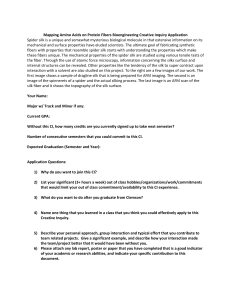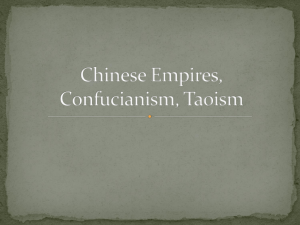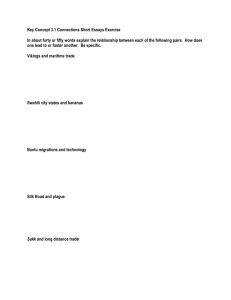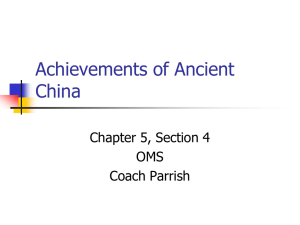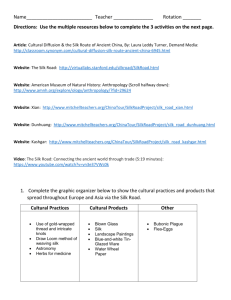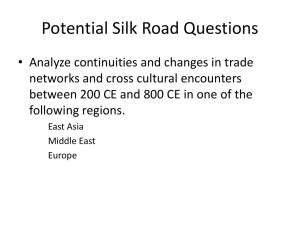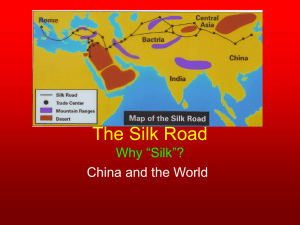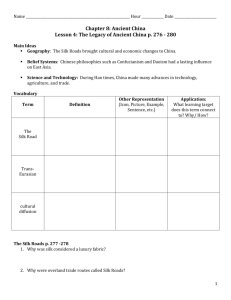Tasawan Silk Enterpriise in Surin
advertisement
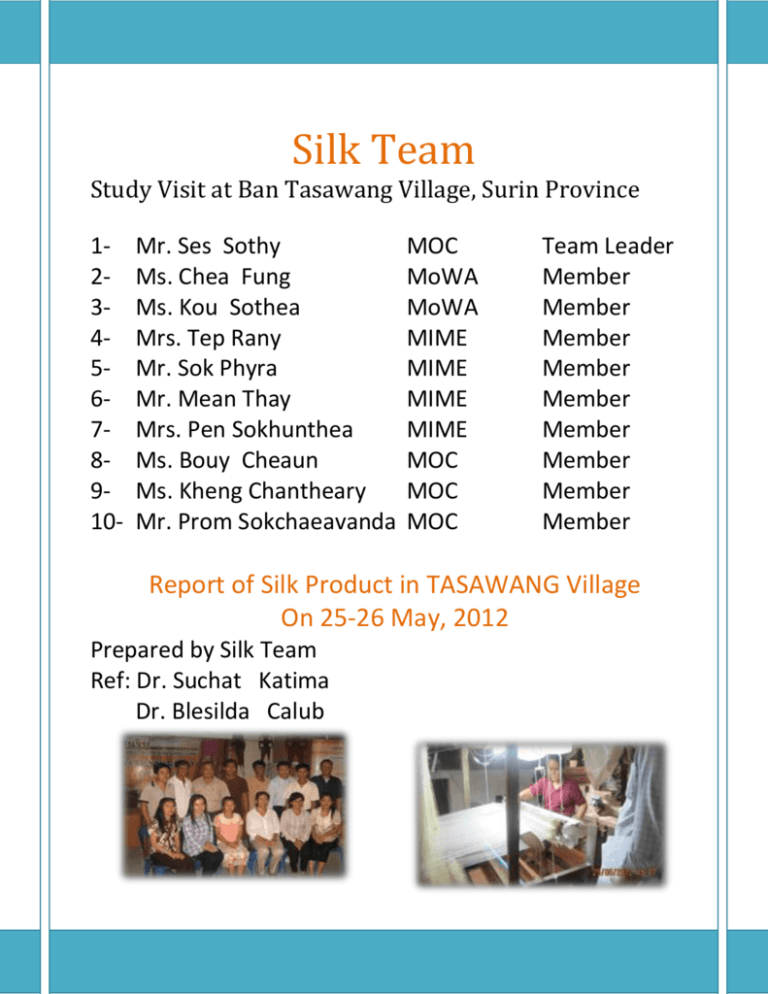
Silk Team Study Visit at Ban Tasawang Village, Surin Province 12345678910- Mr. Ses Sothy Ms. Chea Fung Ms. Kou Sothea Mrs. Tep Rany Mr. Sok Phyra Mr. Mean Thay Mrs. Pen Sokhunthea Ms. Bouy Cheaun Ms. Kheng Chantheary Mr. Prom Sokchaeavanda MOC MoWA MoWA MIME MIME MIME MIME MOC MOC MOC Team Leader Member Member Member Member Member Member Member Member Member Report of Silk Product in TASAWANG Village On 25-26 May, 2012 Prepared by Silk Team Ref: Dr. Suchat Katima Dr. Blesilda Calub TASAWANG SILK VILLAGE IN SURIN I. Introduction: Surin is the elephant city of Thailand. The silk design from Surin has elephants and dancing ladies on it and you can also see soldiers on horseback fighting a battle. Surin is a very famous city and one of the oldest capitals in Thailand. Many battles were fought in ancient times on elephant-back. The Surin Elephant round-up every November has re-enactments of the early battles fought to keep the land these the ancient peoples from China had settled in. Tasawang Silk Village is 10 kilometers out of the Surin city. It was originally a small sleepy village where the women made silk when not planting and picking rice in Thailand. The Thai government was approached by a Thai teacher (called Arjarn Weeratham Trakulngern) with a plan to bring all the women making silk into one village to learn the different techniques for weaving traditional style silk fabric and designs. Arjarn Weeratham convinced the government to spend the money to build large buildings of open air design specifically for the weaving of silk. Fine silk fabric has been being produced in this part of Thailand for over two thousand years. They also have many shops to sell the finished silk and silk products. This is a very interesting place to visit and the area is quite beautiful. Besides the large buildings constructed for the co-operation of silk weavers there are still small places along the road leading into Thasawang Silk Village. You can see silk looms sitting in the front or side yards of many homes in the Isaan area of Thailand. Most are covered with thatch roofs supported on bamboo or wood poles. Some of the looms require up to eight women to make the silk. It can take eight women four months to complete one of the more intricate and difficult designs. Some of these looms are two stories tall. The most expensive silk is woven with gold thread “Indian process” and silk and is extremely breath-taking to see once complete. The silk cloth produced at Tasawang Silk Village is considered some of the best in Thailand. Indian process Surin was commissioned selected the village co-operation to make all the silk jackets for the APEC leaders as a gift from Thailand in October 2003. The Village is supply much of the silk used for the royal family and King and Queen of Thailand. This special pattern of silk is woven in Tasawang village, Muang District about 10 km from Surin downtown. Tourists can visit there for every time. The women and men who work in Tasawang Silk Village is no work schedule or work days they have to be there. If they come to work they get around 200 baht a day (equal 7 USD) for 8 hours/work with an hour off for lunch. If they don't come they just don't get paid for that day. Most of the women and men also farm rice for the planting, growing, and harvesting seasons. After the yield of rice is harvested then they are go back to making silk. There are miles of silk thread being used on these looms. Keeping it all straight and untangled must be very difficult. There are also looms that are placed over a concrete pit in the ground. There a worker will stand and help guide the spindle through the silk, helping two or three other workers above. There is a display at the arjarn's (teacher's) place in the village. These are the materials used to make the different color dyes used to color the silk. These are antique hand-carved wooden silk spools on display at the teacher's, (Arjarn) Weeratham Trakulngernthai, workshop. There is a piece of silk that made for the Queen’s birthday of Thailand. This piece of silk incorporates gold thread in its design. It took sixteen silk weaving artisans four months to make the silk shown here and its duplicate that was given to the queen. Thai-style men shirts are also for sale at Tasawang and could buy silk cloth here and take it to a tailor in Surin. They have many things for sale made by silk such as scarves, pocket books, change purses, pants, dresses, suits, shirts, and all other sorts of neat and pretty silk products and other handmade jewelry, ring. Those of products are reasonable prices. Surin is famous for the high quality and beautiful design of its silk. In Surin Province every village has at least one loom, and in some villages every family has one. In these villages the air resounds with the loud, rhythmic thump-thump of the wooden battens beating the cross-threads or weft to make the finished cloth firm and even. 2. Description of Silk products in Tasawang: - Silkworm breeding in the northeast begins in May or June. - The silk threads are dyed with colors from natural ingredients. For instance, red color comes from lac, and yellow color from turmeric. These threads are woven tightly and elaborately to yield diverse patterns. -'Pha hole', normally of gray, red, white, green, and yellow colors, is woven so tightly that it can hold water on its surface. - The dyes are made from roots, berries, insects and the soil. The lac insect gives a red dye, the indigo plant blue; black comes from the 'krajai' berry, and yellow from a root. The preparation of dyes from these and other raw materials also involves many processes; drying in the sun, pounding, soaking, settling and so on. - Surin people always give 'Pha hole' to their favorite heir. - Villagers always use 'Pha hole' is during special occasions such as wedding ceremony. - Silk weaving is an art craft with a unique style and long history. Its design and color are different from other provinces due to the Cambodian influences. In the past silk was made for using within the household and on special occasions or Buddhist ceremonies. - Style silk has a unique dim color such as brown, red, green, black, and yellow. The silk design is carefully elaborated with tales or auspicious meanings like 'Pha Am Prom', 'Pha An Lui Seam', and 'Pha Hole' which is the 'Queen' of Surin silk. - To produce each 'Pha Yok Thong Boran' is time consuming in making the design, drawing patterns, and collecting 'Ta Kor', the selection of silk yarn, which takes 2-3 months. It takes 1-3 months to finish and at least 4 people in each loom. Each loom produces only 5-7 cm length daily. The silk yarns are dyed from natural ingredients to perform the design followed by a gold thread weaving method from India. This silk is not sold in the market. - The designs, are based on patterns found in nature; elephants, watermelons, scorpions, birds, flowers, snakes and insects. Surin is famous for its elaborate hand woven silk. The ancient silk patterns for example pattern 'HOLE' and pattern 'AMPOROM' are different with colors, thread, dyeing techniques, and weaving styles. The major weaving villages are Sawai village, Tenmee village, Chanrom village in Muang District; Khwao Sinarin village, Napho village in Khwao Sinarin Minor District, Au lok village in Lamduan District. The women of northeast Thailand have spun and woven their own silk and cotton for centuries. Recent archeological discoveries, particularly at Ban Chiang in the northeast, have shown that the techniques of silk cultivation were known to the Thais from their earliest origins when they migrated southward from China some three thousand years ago. Today, as in earlier times, women and girls in the northeast use their free time after the rice has been harvested, to weave cloth for household use or for presenting to monks at Buddhist temple ceremonies. Over the centuries these hardworking women have also learned how to make the best possible use of the local natural products, to create vivid colors for dyeing their home-produced silk yarns and fabrics. 3. Lessions Learnt: Surin is famous for Cambodian style silk weaving. The mechanics of silk weaving are very similar in Thailand and Laos, but the designs, motifs, and detail one can find vary greatly according to the locale. Surin silk is arguably the best in Thailand; certainly it is the best of its type. You can purchase silk directly from the weavers themselves; great deals can be had for textile lovers.

